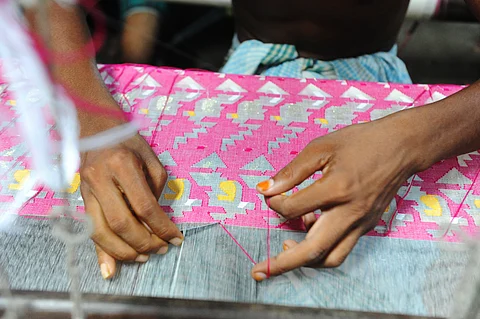
- Destinations
- Experiences
- Stay
- What's new
- Editor’s Picks
- Responsible Tourism
- CampaignsCampaigns
- Subscribe

“Give me the ring that you are wearing on your finger,” said Sukumar Das to my travel companion, “and I will put your doubts to rest.” Taking the ring, Das passed the entire length of the saree – all five metres - through it with room to spare. Although we had heard about ‘muslin’ sarees being passed through a ring, we had dismissed it as a mere tale till Das proved us wrong.
We were at Kalna, a town to the north of Kolkata, around three hours’ drive away. Formally known as Ambika Kalna, the town is a popular tourist destination, known for its intricately carved terracotta temples and its association with Sri Chaitanya, the Vaishnav social reformer from Bengal. However, what most people do not know is that a handful of weavers in Kalna are trying hard to save the dying art of Muslin weaving. Das is one of them.
Muslin (also Moslin) is a superior quality fabric which has been appreciated for its gossamer-like feel. Although some people claim that the name of the fabric originates from Mosul, a city in Iraq, the popular belief is that it originated in Dhaka (earlier part of undivided India, now the capital city of Bangladesh).
According to many textile experts, the fabric was considered a luxury item since the time of the Moghul dynasty, was much appreciated by the wealthy in England, and even exported to Europe. However, to ensure the sale of fabrics produced in the mills of England, the English India Company imposed several restrictions on the traditional weavers of India. Muslin weaving was a labour intensive process and costly. Hence, it could not compete with the cheaper mass produced fabrics. It is also said that the Muslin weavers were often threatened with dire punishments if they did not agree to weave other textiles. Gradually, the art of weaving Muslin faded away.
It is only in the recent past that weavers in Bangladesh and West Bengal (India) are trying to revive the delicate lightweight fabric. In March 2024, the Muslin produced in Bengal earned the Geographical Indication (GI) tag. Called ‘Banglar Muslin’ or ‘Bengal Muslin’, according to the GI Journal 182 (October 2013), "Banglar Muslin is made of cotton, which are spun to create threads that maintained tensile strength at counts (above 300 Counts and up to 600 Counts) i.e., higher than any other cotton products." Kalna is one of the hubs where the finest of Muslins are being woven.
Pointed out Das that the entire process of spinning and weaving has to be done by hand. The fine yarn is hand spun on a specially fabricated ‘charkha’ supplied by the state government. The processing of the yarn is also done by hand. Woven in a pit loom by expert weavers, it takes months to make a sari.
He showed us some exquisite Jamdani Muslins where vivid patterns are woven on the delicate fabric. The patterns, which can be bright or muted were woven on white or coloured backgrounds. Incidentally, Jamdani, which also has a Dhaka origin, was inscribed on UNESCO’s Representative List of the Intangible Cultural Heritage of Humanity in 2013. According to Das, the price of a Muslin sari may start from rupees 30,000 and easily go up to a lakh. “But where are the buyers?” he asks.
“We know how to weave. We will give you the best of products. But we need help in marketing the products,” he said. With a hint of pride he mentioned his sari had been bought by the famous Indian actress Hema Malini and other well-known people. Although Das and other weavers have been to national trade fairs across the country, according to them, such high priced products rarely sell. “Who comes to a fair to buy a sari worth rupees one lakh,” they point out. Another weaver from Kalna showed us swatches of Muslin fabrics made for dress material and Muslin dupattas but said he has stopped making them as there are no buyers.
According to the handful of weavers in Kalna, most in their advanced years, the younger generation is not interested in handloom weaving as it is not a profitable occupation.
As we took our leave, we wondered if the boutiques in Kolkata can come to the aid of these weavers. So if you are looking for a luxurious sari for an occasion or want to buy something special for the upcoming Durga Puja, maybe you may pay a visit to Kalna and visit the Muslin weavers. Tour operators may also consider building a tourist circuit covering the Muslin producing centres of West Bengal.
Kalna in the Purba Bardhaman district of West Bengal can be reached by road and rail. By road, it is about 90km. There are local trains from both Howrah and Sealdah stations. Sukumar Das (contact: +91-6296069126) runs a retail shop at the government marketplace Karmatirtha at Singarkone village in Kalna II CD block. As an office-bearer of the local weaver’s society, he can also put you in touch with other weavers.
